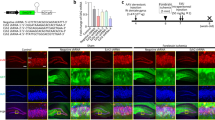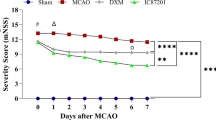Abstract
The present study was performed to examine the effect of fangchinoline, abis- benzylisoquin-oline alkaloid, which exhibits the characteristics of a Ca2+ channel blocker, on cyanide-induced neurotoxicity using cultured rat cerebellar granule neurons. NaCN produced a concentrationdependent reduction of cell viability, which was blocked by MK-801, an N-methyl-D-aspartate (NMDA) receptor antagonist, verapamil, L-type Ca2+ channel blocker, and L-NAME, a nitric oxide synthase inhibitor. Pretreatment with fangchinoline over a concentration range of 0.1 to 10μM significantly decreased the NaCN-induced neuronal cell death, glutamate release into medium, and elevation of [Ca2+]i and oxidants generation. These results suggest that fangchinoline may mitigate the harmful effects of cyanide-induced neuronal cell death by interfering with [Ca2+], influx, due to its function as a Ca2+ channel blocker, and then by inhibiting glutamate release and oxidants generation.
Similar content being viewed by others
References
Ardelt, B. K., Borowitz, J. L. and Isom, G. E., Brain lipid peroxidation and antioxidant protectant mechanisms following acute cyanide intoxication.Toxicol., 56, 147–154 (1989).
Baltrons, M. A., Saadoun, S., Agullo, L. and Garcia, A., Regulation by calcium of the nitric oxide/cyclic GMP system in cerebellar granule cells and astroglia in culture.J. Neurosci. Res., 49(3), 333–341 (1997).
Cai, Z. and McCaslin, P. P., Selective effects of cyanide (100 μ.M) on the excitatory amino acid-induced elevation of intracellular calcium levels in neuronal culture.Neurochem. Res., 17, 803–808 (1992).
Coyle, J. T. and Puttfarcken, P., Oxidative stress, glutamate and neurodegenerative disorders.Science, 262(29), 689–694 (1993).
Ellison, D. W., Beal, M. F. and Martin, J. B., Amino acid neurotransmitters in postmortem human brain analyzed by high performance liquid chromatography with electro- chemical detection.J. Neurosci., 19, 305–315 (1987).
Felix, J. P., King, V. F., Shevell, J. L., Garcia, M. L., Kaczorowski, G. J., Bick, R. and Slaughter, R. S., Bis(benzylisoquinoline) analogs of tetrandrine block L-type calcium channels: evidence for interaction at the diltiazem- binding site.Biochem., 31(47), 11793–11800 (1992).
Freund, W. and Reddig, S., AMPA/Znp2+-induced neurotoxicity in rat primary cortical cultures: involvement of L-type calcium channels.Brain Res., 654, 257–264 (1994).
Gunasekar, P. G., Borowitz, J. L. and Isom, G. E., Cyanide- induced generation of oxidative species: involvement of nitric oxide synthase and cyclooxygenase-2.J. Pharmacol. Exp. Ther., 285(1), 236–241 (1998).
Gunasekar, P. G., Kanthasamy, A. G., Borowitz, J. L. and Isom, G. E., Monitoring intracellular nitric oxide formation by dichlorofluorescin in neuronal cells.J. Neurosci. Meth., 61, 15–21 (1995).
Gunasekar, P. G., Kanthasamy, A. G., Borowitz, J. L. and Isom, G. E., NMDA receptor activation produces concurrent generation of nitric oxide, a reactive oxygen species: implication for cell death.J. Neurochem., 65(5), 2016–2021 (1995).
Gunasekar, P. G., Sun, P. W., Kanthasamy, A. G., Borowitz, J. L. and Isom, G. E., Cyanide-induced neurotoxicity involves nitric oxide and reactive oxygen species generation after N- Methyl-D-aspartate receptor activation.J. Pharmacol. Exp. Ther., 277, 150–155 (1996).
Ivanovska, N., Hristova, M. and Philipov, S., Complement modulatory activity of bisbenzylisoquinoline alkaloids isolated from isopyrum thalictroides-ll. Influence on C3-9 reactions vitro and antiinflammatory effect in vivo.Int. J. Immunopharmacol., 21(5), 337–47 (1999b).
Ivanovska, N., Nikolova, P., Hristova, M., Philipov, S. and Istatkova, R., Complement modulatory activity of bisbenzylisoquinoline alkaloids isolated from isopyrum thalictroides-I. Influence on classical pathway in human serum.Int. J. Immunopharmacol., 21(5), 325–36 (1999a).
Jiangsu college of New Medicine,Encyclopedia of Material Medica, vol. 1. Shanghai People’s publishing House, Shanghai, China, pp. 981–985 (1975).
Johnson, J. D., Conroy, W. G., Burris, K. D. and Isom, G. E., Peroxidation of brain lipids following cyanide intoxication in mice.Toxicology, 46(1), 21–28 (1987).
Kawashima, K., Hayakawa, T., Miwa, Y., Oohata, H., Suzuki, T., Fujimoto, K., Ogino, T. and Chen, Z. X., Structure and hypotensive activity relationships of tetrandrine derivatives in stroke-prone spontaneously hypertensive rats.Gen. Pharmacol., 21, 343–347 (1990).
Kim, H. S., Zhang, Y. H., Fang, L. H., Yun, Y. P. and Lee, M. K., Effects of tetrandrine and fangchinoline on human platelet aggregation and thromboxane B2 formation.J. Ethnopharmacol., 66(2), 241–246 (1999).
Kim, H. S., Zhang, Y. H., Lee, M. K. and Fang, L. H., Inhibitory effects of fangchinoline on dopamine biosynthesis in PC12 cells.Med. Sci. Res., 26, 475–476 (1998).
Kim, H. S., Zhang, Y. H., Oh, K. W. and Ahn, H. Y., Vasodilating and hypotensive effects of fangchinoline and tetrandrine on the rat aorta and the stroke-prone spontaneously hypertensive rat.J. Ethnopharmacol., 58, 117–123 (1997).
Kim, S. D., Oh, S. K., Kim, H. S. and Seong, Y. H., Inhibitory effect of fangchinoline on excitatory amino acids-induced neurotoxicity in cultured rat cerebellar granule cells.Arch. Pharm. Res., 24(2), 164–170 (2001).
Lee, Z. W., Kweon, S. M., Kim, B. C., Leem, S. H., Shin, I. C., Kim, J. H. and Ha, K. S., Phosphatidic acid-induced elevation of intracellular Cap2+ is mediated by RhoA and H202 in rat-2 fibroblasts.J. Biol. chem., 22, 12710–12715 (1998).
Leung, Y. M., Kwan, C. Y. and Loh, T. T., Dual effects of tetrandrine on cytosolic calcium in human leukaemic HL-60 cells: intracellular calcium release and calcium entry blockade.Br. J. Pharmacol., 113, 767–774 (1994).
Lin, L. Z., Shieh, H. L., Angerhofer, C. K., Pezzuto, J. M., Cordell, G. A., Xue, L., Johnson, M. E. and Ruangrungsi, N., Cytotoxic and antimalarial bisbenzylisoquinoline alkaloids from cyclea barbata.J. Nat. Prod., 56, 22–29 (1993).
Liu, Q. Y., Li, B., Gang, J. M., Karpinski, E. and Pang, P. K., Tetrandrine, a Cap2+ antagonist: effects and mechanisms of action in vascular smooth muscle cells.J. Pharmacol. Exp. Ther., 273, 32–39 (1995).
Manev, H., Costa, E., Wroblewski, J. T. and Guidotti, A., Abusive stimulation of excitatory amino acid receptors: a strategy to limit neurotoxicity. [Review] [46 refs]FASEB J. 4(10), 2789–2797 (1990).
Mei, J. M., Chi, W. M., Trump, B. F. and Eccles, C. U., Involvement of nitric oxide in the degeneration of cytosolic calcium in cerebellar neurons during combined glucose- oxygen deprivation.Mol. Chem. Neuropathol., 27(2), 155–166 (1996).
Mosmann, T., Rapid colorimetric assay for cellular growth and survival: Application to proliferation and cytotoxicity assays.J. Immunol. Methods, 65(1–2), 55–63 (1983).
Nakamura, K., Tsuchiya, S. and Sugimoto, Y., Histamine release inhibition activity of bis-benzyl-isoquinoline alkaloids.Planta Med., 58, 505–508 (1992).
Patel, M. N., Ardelt, B. K., Yim, G. K. W. and Isom, G. E., Cyanide induces Cap2+ dependent and independent release of glutamate from mouse brain slices.Neurosci. Lett., 131, 42–44 (1991).
Pauwels, P. J., Van Assouw, H. P., Leysen, J. E. and Janssen, P. A. J., Cap2+-mediated neuronal death in rat brain neuronal cultures by veratridine: protection by flunarizine.Mol. Pharmacol., 36, 525–531 (1989).
Rothman, S. M., Synaptic release of excitatory amino acid neurotransmitter mediates anoxic neuronal death.J. Neurosci., 4, 1884–1891 (1984).
Seong, Y. H., Koh, S. B. and Jo, S. O., Protective effects of ginsenosides on cyanide-induced neurotoxicity in cultured rat cerebellar granule cells.J. Ginseng Res., 24(4), 196–201 (2000).
Sun, F. and Liu, T. P., Tetrandrine vs. nicardipine in cerebral ischemia-reperfusion damages in gerbils.Chung-Kuo Yao Li Hsueh Pao-Acta Pharmacologica Sinica. 16(2), 145–148 (1995).
Sun, P. W., Rane, S. G., Gunasekar, P. G., Borowitz, J. L. and Isom, G. E., Modulation of the NMDA receptor by cyanide: Enhancement of receptor-mediated responses.J. Pharmacol. Exp. Ther., 280, 1341–1348 (1997).
Takemura, H., Kwan, C. Y. and Ohshika, H., Calcium antagonistic actions of tetrandrine depend on cell types.Res. Com. Mol. Pathol.. & Pharmacol., 90(1), 59–68 (1995).
Uitti, R. J., Rajput, A. H., Ashenhurst, E. M. and Rozdilsky, B., Cyanide-induced parkinsonism.A Clin. Pathol. Rep. Neurol., 35, 921–925 (1985).
Van Vliet, B. J., Sebben, M., Dumuis, A., Gabrion, J., Bockaert, J. and Pin, J. P., Endogenous amino acid release from cultured cerebellar neuronal cells: Effect of tetanus toxin on glutamate release.J. Neurochem., 52(4), 1229–1230 (1989).
Vanning, T., DreJer, J., Frandsen, A. and Schousgoe, A., Characterization of a chemical anoxia model in cerebellar granule neurons using sodium azide: protection by nifedipine and MK-801.J. Neurosci. Res., 44, 40–46 (1996).
Way, J. L., Cyanide intoxication and its mechanism of antagonism.Annu. Rev. Pharmacol. Toxicol., 24, 451–481 (1984).
Weiss, J. H., Hartley, D. M., Koh, J. and Choi, D. W., The calcium channel blocker nifedipine attenuates slow excitatory amino acid neurotoxicity.Science, 247 (4949 Pt 1), 1474–1477 (1990).
Author information
Authors and Affiliations
Corresponding author
Rights and permissions
About this article
Cite this article
Cho, S.O., Seong, Y.H. Protective effect of fangchinoline on cyanide-induced neurotoxicity in cultured rat cerebellar granule cells. Arch Pharm Res 25, 349–356 (2002). https://doi.org/10.1007/BF02976638
Received:
Issue Date:
DOI: https://doi.org/10.1007/BF02976638




